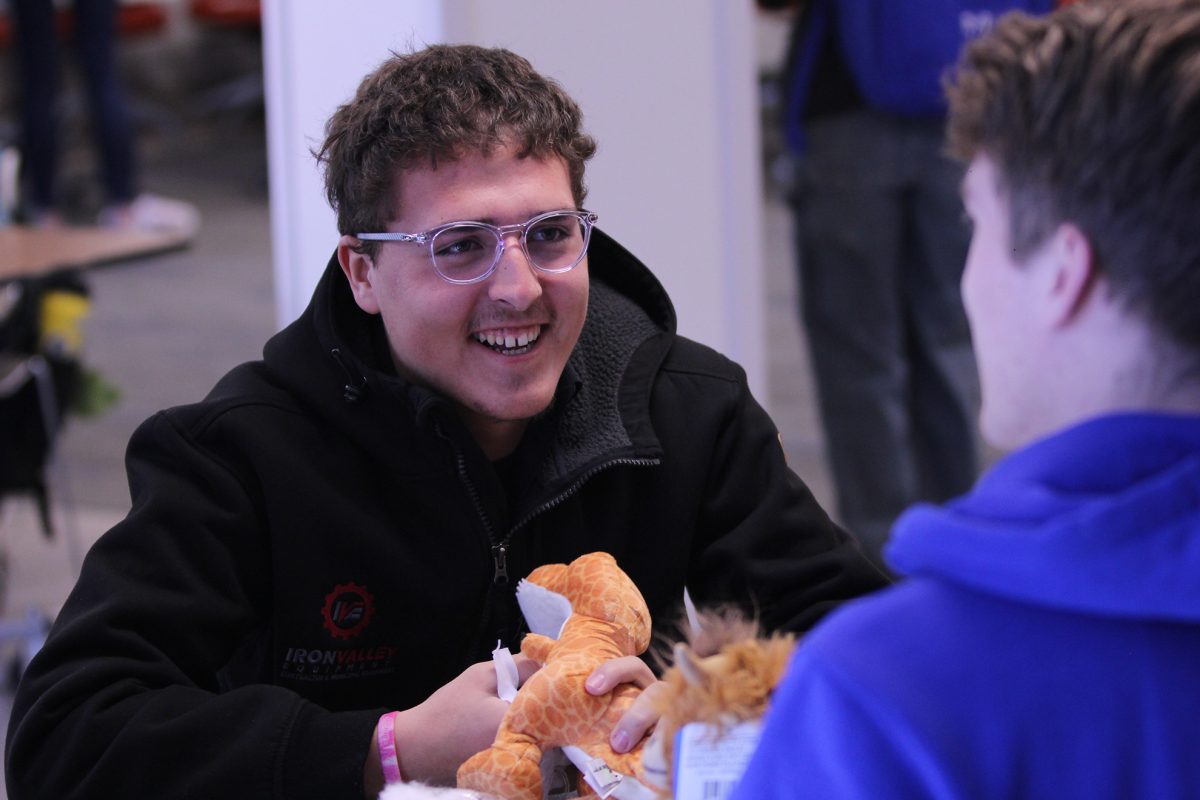Assistant professor Dr. Adam Jensen explains how thousands of exoplanets can be detected with billions thought to exist
Jessica Turek
Antelope Staff
The discovery of the exoplanet 51 Pegasi b in 1995 was the beginning of a minefield of new planets discovered outside of our solar system, according to NASA. Dr. Adam Jensen, assistant professor of the UNK Physics Department, said we know about thousands but also know billions more likely exist.
Jensen presented “Understanding Other Worlds” Friday Jan. 27 and lectured about the different ways the exoplanets are detected by scientists today, including the radial velocity method, transit method and direct imaging.

Dr. Adam Jensen, an assistant professor in the University of Nebraska at Kearney’s Department of Physics and Physical Science, leading a group that will explore the existence and evolution of exospheres around exoplanets, the outer ‘unbound’ portion of a planet’s atmosphere.
Radial velocity
The first notable method is radial velocity.
The larger gravitational pull belongs to the star, therefore causing planets to revolve around them. However, planets have a small gravitational pull on stars causing them to wobble, even if just slightly.
Scientists are able to detect these wobbling stars with the “Doppler shift’ method, created about 150 years ago by physicist Christian Doppler.
The Doppler shift method is the stretching and squeezing of energy waves as they move closer or farther away from an object. Scientists use this knowledge and technology to detect any significant changes in a star’s light waves, a form of energy wave, throughout time.
If the light waves are both squeezed and stretched over time, then a wobble in a star can possibly be detected. Light waves show different colors when they are squeezed and stretched. Closer together the color is redder; farther away the color is bluish.
Transit method
In the second method, transit, scientists use the ‘light curve’ to observe a drop in a star’s regular light brightness, which can indicate a planet in front of a star. The light curve is a continuous line, dropping when there is a blockage of light.
The size and length of an exoplanet can be detected as well on the light curves. A larger planet will block more light, causing a larger drop in the light curve than a smaller planet. The farther away a planet is, the longer the planet will take to travel across the front of the star. Therefore, the longer the drop will remain on the curve.
Jensen focused his research on part of the transit method. He focused on the subtle color difference in the star’s light passing through the planet’s atmosphere. Jensen said, “The light coming through that atmosphere, what we call certain colors or wavelengths, will get absorbed by the atmosphere and other ones will pass through.”
Direct imaging
The third method, direct imaging, allows scientists to take pictures of exoplanets by removing most of the light given off by the star.
Jensen’s interest in exoplanets stemmed from the dramatic increase of evidence throughout his time growing up, going to college and becoming a professor. “Now we know about thousands and from there we can extrapolate the billions in our own galaxy. That’s really exciting,” said Jensen.
Looking toward future
Jensen hopes in the long-term, 20 to 30 years from now, scientists will be able to study an exoplanet’s atmosphere to understand similarities to the earth’s atmosphere in a richer context than they are able to today. In an optimistic example, they even might be able to look for characteristics of life.
Jensen said, “Our atmosphere is out of equilibrium to what one would expect in the presence of life. If we did not have life on Earth, the oxygen in our atmosphere would cease to exist, but oxygen does exist from a cycle caused by life.
“That is a part of one of these ultimate goals — to use these techniques to look for that sort of thing,” Jensen said.
“The current technology makes looking for an Earth-like atmosphere on smaller Earth-like planets difficult. Scientists can only attempt to see certain, big atmospheric features from planets, which are typically a bit larger than the Earth,” Jensen said.
Jensen is not sure when scientists could send a robotic missions or person to an exoplanet, saying, “We have only sent humans as far as the moon. And then we sent robotic missions to actually get to the edge our own solar system and a little bit beyond, but you need to get several times further to get the next star.”
Jensen thinks robotic missions are possible with technological advances. “To get some kind of robotic mission to an exoplanet, you know, I think that that is something that is conceivable within the next few decades; or I sort of expect them in the next hundred years or so, maybe sooner,” Jensen said.
He said the problems of sending a person to an exoplanet are much more complex because of the multitude of issues that would be needed to be taken in account, including a spacecraft that would withhold transporting people.
“To me that’s not really on the horizon, but the robotic mission,” Jensen thoughtfully said, “I think that is the distant horizon, but people are already talking about it. People are already starting to develop that.”
Exoplanets today
NASA has confirmed 3,442 exoplanets with 4,696 candidates in 2,571 solar systems with the majority consisting of ice giants and gas giants, yet 781 are super-earths and 348 are terrestrial. This knowledge opens the possibility of exploring for existing life in the future on one of these planets.






























